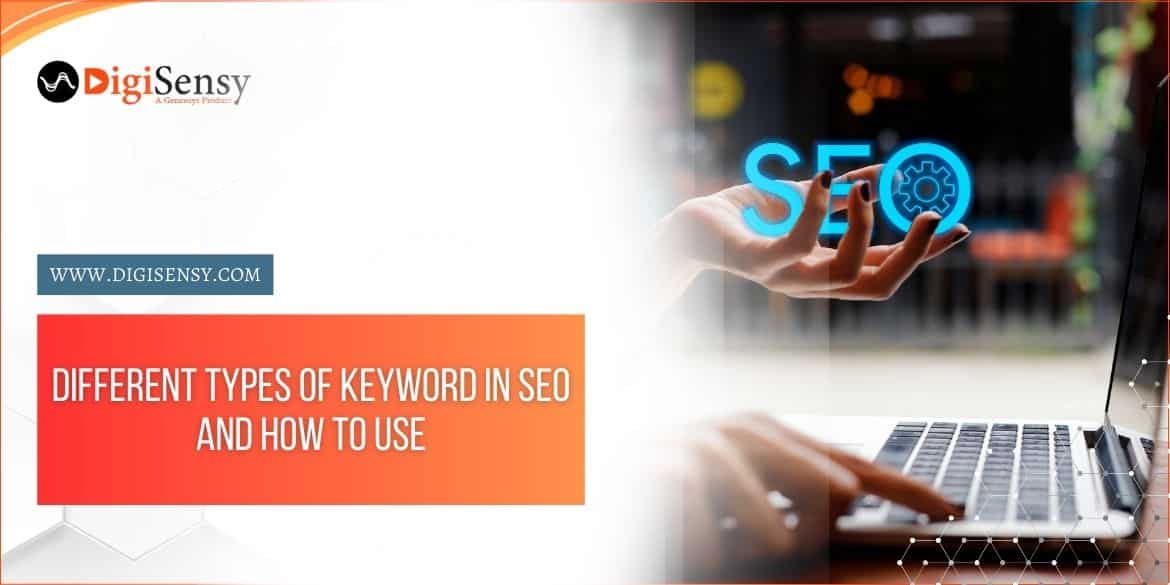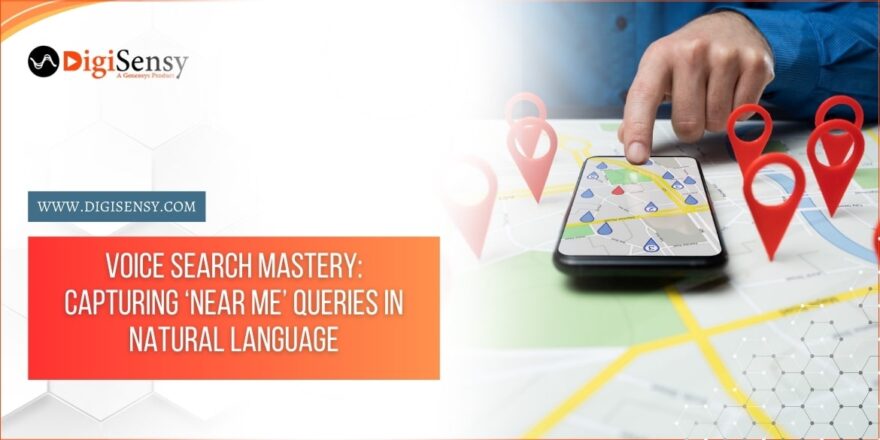Why does a website earn a first-page placement in Google SERPs? Simply put, a significant consideration behind this is keyword utilization. Whether you run a blog, tend to a business website, or sell products online, a comprehension of keywords is paramount in SEO (Search Engine Optimization).
At Digisensy, the general belief is that well-researched and strategically used keywords are the baseline for any digital strategy. This blog will serve to introduce you to what difference types of keywords in SEO are, their importance, different types that you should know, and how to properly apply keywords to generate website traffic.
What Are Keywords in SEO?
A user enters words or phrases in a search engine such as Google or Yahoo, seeking information, products, or services. Keywords are basically a bridge between what has been sought for and the kind of content you offer on the website or blog.
So if one means buying a certain kind of sports shoe, he searches for the query “best running shoes for men.” The entire phrase constitutes one keyword. Should your site feature these words or an article containing that very phrase, Google might very well represent your page in the search results. Keywords are those connecting roads from your content to the search intent of your users.
Why Are Keywords Important in SEO?
Keywords are essential attributes that basically help the search engine to understand the subject matter of the content on your website. If wielded correctly, keywords provide visibility to your content against people searching online for related topics or solutions.
Conventionally, tickets and keywords in SEO are used to likewise increase the visibility of your website on search engines, to have as much organic traffic to get your right content to the right audience, and to raise relevance and help structure your site content so that search engines could readily index your pages with that specific user query. In addition, these terms allow you to gear your business ahead of your competition by focusing on niche words that potential clients are using.
Types of Keywords in SEO (With Structure and Examples)
Keywords, however, do not all serve the same goal. They can be sorted based on their length, their function, or their intent. If you grasp these different types of keywords, you will be able to work on a much more focused SEO approach.
-
Short-Tail Keywords (Head Keywords)
Short-tail keywords contain no more than one or two words. “Shoes” would be one, as would “marketing” or “travel.” These search terms are very broad and, thus, come with high volumes of search traffic. They also would stand as a competitor for a high-intensity set of keywords and generally have too generic aspects to cause conversion. Hence, they have no distinctive intent attached to them; it becomes difficult to determine what the searcher expects.
Use short-tail keywords on very general pages such as your homepage or top-level category pages. Though they are hard to rank for, they still have their basket full of traffic when combined with longer and more specific keywords.
-
Long-Tail Keywords
Long-tail keywords are phrases that contain three or more words more often than not. “Best running shoes for flat feet” and “affordable SEO services for startups” are examples. They are more specific keywords that usually demonstrate a clear user intention: either to make a purchase or find a way to remedy a problem.
They have less search traffic than short-tail since they focus more on activities, but they have better conversion rates. Good candidates are blog posts, product pages, or service descriptions. On the other hand, long-tail keywords can get you up the rankings with far less effort while bringing potential visitors who are much more likely to act.
-
LSI Keywords (Latent Semantic Indexing)
LSI keywords are keywords related to your main keyword. These keywords assist search engine crawlers in assigning meaning and context to your content. For instance, if the basis keyword is Apple, LSI keywords would possibly include iPhone, MacBook, or tech company, depending on the context.
Such keywords are not true synonyms but do carry an additional meaning and contribute to the depth of your content. Using LSI keywords in content prevents keyword stuffing and, therefore, increases relevance. They should be used naturally throughout the page in subheadings, image alt text, and the main body content.
-
Branded Keywords
The branded keywords contain the name of a specific brand. Some examples include “Nike running shoes” and “Digisensy SEO services.” These keywords are more often searched for by those users who already know about the brand and are now interested in locating specific information, products, or services related to it.
Branded keywords assist in building brand visibility and customer loyalty. They have relatively low competition unless it is a very famous brand. Branded keywords should be present on your homepage and product or service pages, as well as in pay-per-click ads.
-
Non-Branded Keywords
Non-branded keywords do not include any brand name. For instance, a user might type “best digital marketing agency” or “custom website development.” People with such key phrases are exploring possibilities but have not yet selected a certain brand.
Targeting non-branded keywords is critical for getting new visitors who may be unaware of your business yet. Ideal for establishing awareness through blog posts, landing pages, and product descriptions.
-
Transactional Keywords
Training keywords, for example, are used when a person wants to perform some action–buying or signing up. The examples would include “buy an LED TV online” or “book a hotel in Goa.” The existence of buyer intent is strong for these keywords and hence can often be found at the bottom half of the sales funnel.
These users, being ready to go ahead with an action, can thus target transactional keywords, which means they might go on to conversion. Transactional keywords are to be implemented in product pages, checkout pages, and promotional landing pages. Make sure there’s plenty of content around the keyword with a strong call to action.
-
Informational Keywords
Those types of keywords are used by those who want to learn or, rather, seek answers. For instance, how to start a blog, what digital marketing is, the advantages of organic food, etc. Such keywords are usually located above the funnel, which means the user is already in their early research phase.
Building content around the informational keywords allows one to build trust and establish authority. A CSV should be used in blog articles, how-to guides, FAQs, and tutorial videos. Using them might not result in an immediate purchase, but they do increase long-term engagement and enhancements in authority.
-
Navigational Keywords
These are the terms searched by online consumers to find a particular website or webpage: Facebook login, HubSpot pricing, or the Digisensy blog. This implies that they already have an idea of where they want to go and are now trying to reach there through the search engine.
Now, your website should be optimized to capture navigational keyword traffic relating to your brand. Place these keywords in your metadata, page titles, and navigation menus so that your content can be searched and found when someone is searching for it.
-
Geo-Targeted (Local) Keywords
These keywords are location-specific or geo-specific and would include search phrases like “SEO company in Delhi” and “best restaurants in Mumbai.” Such keywords are important. Use your local keywords on your local landing pages, business listings, and Google My Business profile. Location-based keywords put your business on local search and map results and thereby give you an edge in attracting local traffic.
-
Seasonal Keywords
Seasonal keywords lose their popularity during certain times of the year, such as “Valentine’s Day gift ideas” and “summer vacation packages.” During special occasions or seasons, these keywords gain high traffic if well-timed.
Plan ahead for months to create content or a campaign around these seasonal keywords. Keep content updated or schedule content updates to appear before the season kicks in so that they will be indexed by search engines and attract visitors during the peak interest periods.
How to Use Keywords Effectively in Your SEO Strategy
Choosing the right keywords is merely half the battle. It is equally important to know how to strategically incorporate them into your content. Below are some common considerations:
Start by extensively researching keywords using Google’s Keyword Planner, or alternatively, take advantage of competitors’ platforms such as Ubersuggest or SEMrush. Focus on those keywords for which an equal balance exists between search volume and competition, and that closely coincide with your business goals. In determining the essence of the search intent, consider an example: a person searching for “build a website” fits an informational search query. Action is required if the search is for “hire a web developer.”
Insert the keywords you want to rank for in the most important parts of your page: page title, URL, meta description, headings, and within the first 100 words of the text.
Keywords are where the power of a robust SEO strategy lies. Knowing about different types of keywords- short-tail, long-tail, branded, informational, and local you can start generating content aimed at reaching clients during different stages of the search process. Be careful not to overdo this. Keyword stuffing will work against you in the algorithm. Try using variations and related terms to have natural phrasing that engages the reader.
Review your content organization to combine topic clusters with one big “pillar” page with several smaller blog posts supporting it. This structure enhances internal linking and helps search engines better perceive the associations between your pages.
Lastly, keep an eye on your keyword performance through tools like Google Search Console and Analytics. Update your content to keep your relevance and rank up with time.
Conclusion
Keywords constitute the basis of a good SEO strategy. By exploring various types of keywords, whether short-tail, long-tail, branded, informational, or locally based, you can tailor the content to the span in between where customers are searching.
At Digisensy, we assist businesses in adopting smart keyword strategies to improve online visibility and to reach the correct audience groups to avoid most common keyword mistake in SEO. Depending on your project-given it is anything from creating a blog to launching a marketing campaign, local SEO and the right keyword selection make the potential for successful results.
Research first, then match your keywords to the intent of your goal, and finally promote the natural use of these keywords throughout your content. In the long term, this will bring much more traffic, build more trust, and enhance business online.




